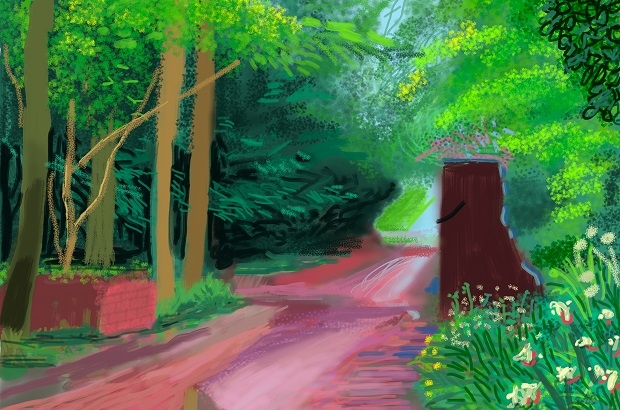- Daily & Weekly newsletters
- Buy & download The Bulletin
- Comment on our articles
David Hockney expresses his passion for nature in the company of Van Gogh, Munch, Mahler and other artists in new exhibition at Mons
Prolific British artist David Hockney takes centre stage at Mons’ exhibition Le Chant de la Terre (The Song of the Earth) for a joyous, albeit nuanced exploration of the profound relationship between man and nature.
This luminous show at the city’s fine arts museum features the 88-year-old’s recent paintings and iPad landscapes. They are the creative outpourings of an influential artist who over seven decades has constantly innovated while never eschewing his distinctive painterly skills.

Hockney’s fascination for capturing immersive, impressionist-like nature scenes is contrasted with similar expressions by other artists, notably Van Gogh, Munch, Meunier and Nordic Symbolist artists. Reinforcing their intimate relationship with nature is Gustav Mahler's 9th symphony, also known as the Song of the Earth, that serves as a soundscape for the exhibition.
Written shortly before the composer’s death when he was grieving the death of his young daughter, the epic work serves as a central thread, says curator Isabelle Cahn, from the Musée d'Orsay in Paris. “It invites a reflection on the tension between the grandiosity of these landscapes and the fragility and brevity of human life.”
Spread across six sections and incorporating three audio-visual installations, it encompasses themes of mother earth, fields, seasons, flowers and solitude. The resulting meditative journey is designed to directly engage viewers, in particular around Hockney’s lifelong eye for nature and pleasure in the simpler things in life.
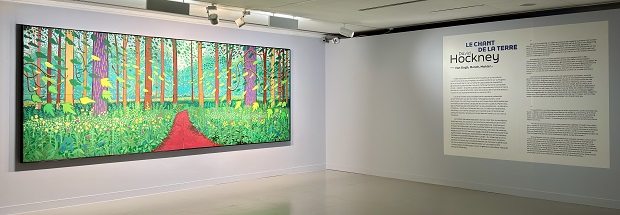
The show opens with his panoramic Untitled 02 (The Arrival of Spring), a lush introduction (pictured above) to his latter landscape series, and a result time spent in his native Yorkshire. A ruby red road at the centre of the eight-canvas composition draws in the viewer’s eye, from the spring florals in the foreground and past the regiment of trees to a swirling green woodland copse in the background. The playful primitive paint effects contrast with the sophistication of the perspective.
It shares the space with a bust of Mahler by Rodin, while an intimate side room is dedicated to an expansive video and sound installation immersing the viewer in the landscape of the expansive Dolomites. It was here in a wooden cabin that the German composer wrote the score for the introspective work, completed in 1909 and regarded as an emotinal farewell to life.
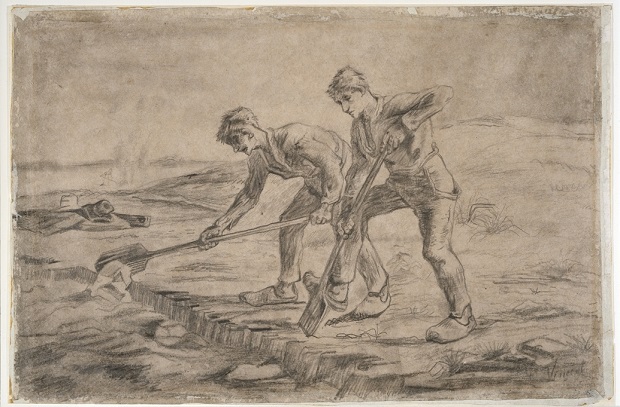
A dialogue then ensues with Van Gogh, an artist already honoured at the museum – in 2015 – for the period he spent in the Borinage. It was here in the region’s mining area that he decided to embark on a career as an artist and remained profoundly influenced by the ordinary people he met there. The chalk work The Diggers (1880), pictured above, conveys the daily toil of those working the land. It is an example of the Dutchman’s admiration for Jean-François Millet, while other artists who inspired him are represented here, including Belgian Constant Meunier and Jules Bréton, whose magnificent oil La Glaneuse (1888) depicts a realist scene of agricultural life.
If there is an air of melancholy in these portrayals of peasant work, Finnish artist Ellen Thesleff injects an air of light relief in a portrait of two young gleaners. Her expressive brushwork captures the figures in motion, bright colours imbuing the scene with joy. Interestingly, she also had a musical education and one figure can be seen extracting sound from a blade of grass.

An autumnal theme follows: all russet tones with an arced installation dedicated to Mahler’s 5th movement setting the mood for the season of renewal. A series of still lifes in earthy hues by Van Gogh make way for a large-scale work by Hockney from his iPad series The Arrival of Spring in Woldgate, East Yorkshire in 2011 – 29 January (extract pictured). Bare spindly branches form an arch over a pathway disappearing into the distance; their acid green forms contrasting with the pink and red hues of the undergrowth below.
Further declinations in the spring section herald the warmer season with an explosion of light and lush vegetation. Spontaneous squiggles highlighting blossom and vigorous signs of life, the commonplace hawthorn bush transformed into a candy floss object of beauty (pictured below). During lockdown in 2020, Hockney retired to his Normandy farmhouse, where he recorded all four seasons. A sunny panorama filled with its beamed buildings, winding lanes and dappled orchards invites contemplation on perceptions of memory and temporality.
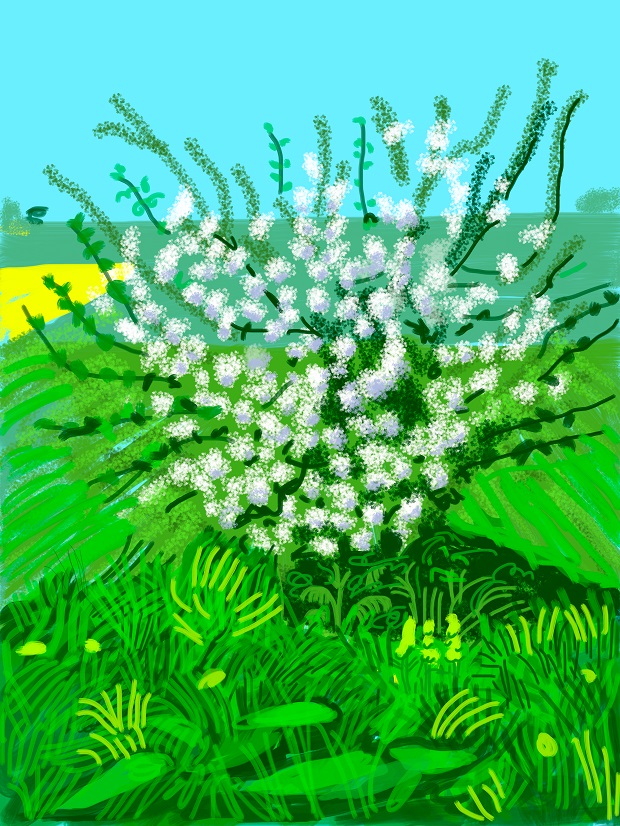
While Hockney’s move to digital paintings enabled him to instantly capture the surrounding countryside while working outside in the style of the impressionists, they also divide the crowds with some lamenting the stunning portraits and California sun-blazed pool scenes that confirmed his global reputation.
Yet, continually absorbed by the question of perspective, Hockney experiments with vanishing planes to achieve his goal of minimising the distance between the artwork and the viewer. The exhibition takes a sidenote to explore his playful approach to viewpoints, while a video installation demonstrates European techniques through the ages.
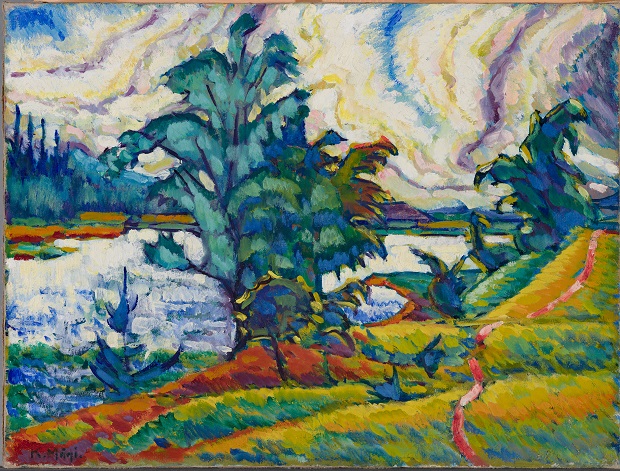
Norwegian artist Edvard Munch was another inspiration for Hockney; a landscape by the expressionist shows a similar interest in plays on perspective. The Briton was drawn to northern painters’ sense of solitude isolation and painted from his own travels to the vast empty landscapes of Norway and Iceland. A richly-hued visionary landscape by Estonian modernist Konrad Mägi (pictured above) adds to the mysticism of this section.
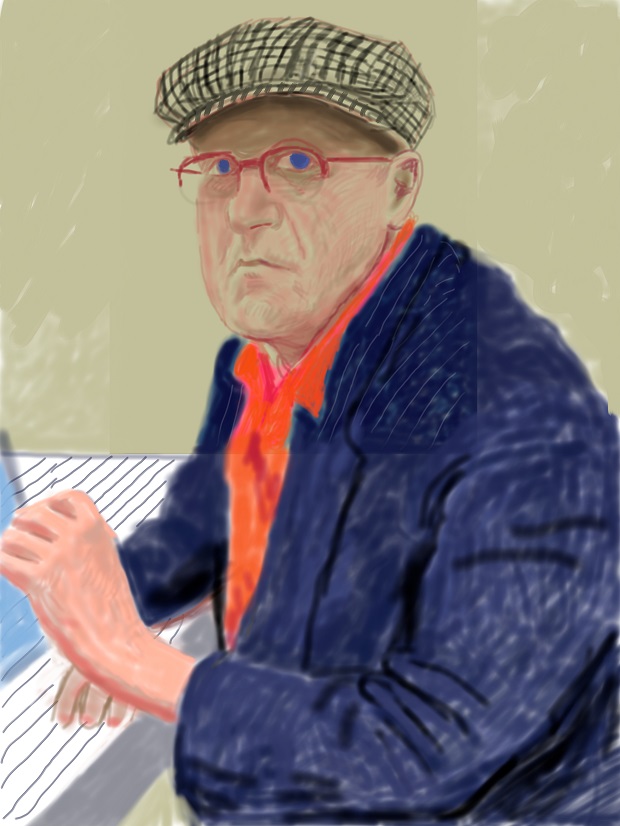
From lands of the midnight sun to the final movement of Mahler’s song cycle and a triptych of paintings by Hockney and an iPad-drawn self-portrait (pictured above) conclude the show. The rendition of the artist is a trademark balance between introspection and exhibition. A tweed flat cap is perched jauntily atop his head, while sprightly specs and scarf reflect an ever vibrant palette and outlook. The modern and pop art master may be in the swansong of his life, but he’s forever a passionate observer of life.
If Hockney has always explored “the small space between art and life,” one of the challenges in staging this exhibition was to ensure viewers experienced an emotional response an connection to the works, says Xavier Roland, director of the CAP (Culture, Art and Patrimoine) museum complex.
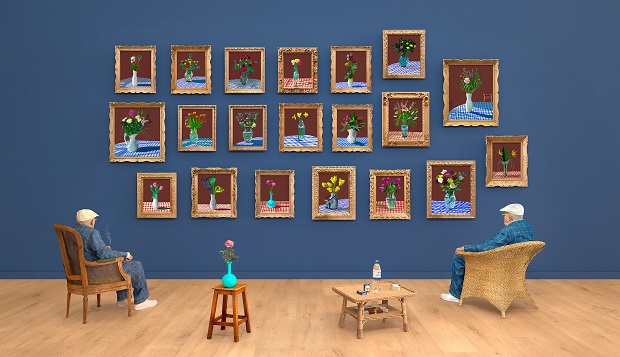
“When Van Gogh was in Mons and starting to be an artist, his goal was not to create a beautiful canvas but to give it a kind of transmission of what he was living and his devotion to the local population,” explains Roland, who credits Hockney for similar qualities. “He is talking to everybody. It is not because the colours are beautiful, it is not because his works are pleasant to see, there is authenticity in the way he works.”
It is the veracity of these artists’ work that underpins the positivity of the exhibition and makes it relevant, says Roland. “I strongly believe that when art is ‘juste’, it can make people better… If you see beautiful things, you feel better and you want to make good around you. It is particularly important today to make people positive and happy.”
David Hockney: Le Chant de la Terre
4 October to 25 January
Rue Neuve 8
Mons
The CAP is also showing two accompanying exhibitions. Local visual artist Kevin Douilles presents Voyages d'un geste, in which he expresses vividly his inner landscapes and emotion. Dutch artist Emmy Bergsma shows the fruits of her residency at the Van Gogh House in Cuesmes in a series of charcoal drawing following a physical immersed in the local environment.
Photos: (main image) Extract The Arrival of Spring in Woldgate, East Yorkshire in 2011- 11 May ©David Hockney/Collection Ernst; ©BE CULTURE; ©BE CULTURE; Les Bêcheurs - V. van Gogh ©Ville de Mons; Extract The Arrival of Spring; The Arrival of Spring in Woldgate, East Yorkshire in 2011- 30 April ©David Hockney/Collection Ernst; Konrad Mägi Lake Pühajärv 1918–192 Art Museum of Estonia ©Stanislav Stepashko; Self Portrait II, 14th March 2012 ©David Hockney, Courtesy Galerie Lelong; ©BE CULTURE


